Instead of screaming into the void of Twitter, I bring you a weekly highlight reel of what it’s like going places in Greater Hartford when one is gloriously car-free. These posts are on a slight time delay because nobody needs to know exactly where I am when I am there.
Some weeks are a blur. If I don’t write down the thoughts as I go, I forget the minutiae. That’s fine. It’s not like going from place-to-place is especially noteworthy, except for when people treat it as such because your mode is not the norm for that of a particular socioeconomic class. Not that I belong to that class.
While walking through my neighborhood — Putnam Street, Russ Street, Babcock Street — I notice how many pieces of hair are on the sidewalk. Braids that once looked nice, probably, attached to someone’s head, but now look creepy, disembodied as tumbleweeds — tumbleweaves — in the gutter. A new-to-me sight: a full set of pink press-on nails, abandoned on the sidewalk. I always wonder about how certain litter winds up where it does. Did someone stop right there and decide they were done with their nail daggers, ripping them off and tossing them to the curb? Were these in the trash but dragged out by squirrels? Thrown from a car window?
The next morning I hear about a murder on that block of Babcock Street I’d just walked by. Not a first for there or nearby Russ. It’s upsetting for all the reasons that unnecessary loss of human life is upsetting, but my response doesn’t fit neatly into the narrative that local news have trotted out, the one that declares how residents are scared to leave their homes. It must be true for some. There’s always one person willing to get in front of a microphone and say it. But it’s not what I see. There are still people who leave their homes, that same day. Scared or not. There are kids who play in the streets here, because that is the kind of neighborhood this is. For me, the presence of children playing on the streets, the sidewalks, the front yards, that was a major draw to this particular neighborhood. I have lived places where kids are relegated to backyards, if they are outside at all. There’s something that feels toxic about those kinds of places.
Guns and cars. Guns and cars.
Our laws make access to both easier than it should be.
There are those who don’t see the point of strengthening laws, citing how some traffic deaths and some gun deaths are the result of people who have accessed cars and firearms illegally. Their logic does not hold. Because an action does not solve every instance of the problem, we should maintain the status quo? I don’t think so.
They beat the drum of personal responsibility, but we have insisted on that over and over and gotten the same disappointing results.
When I go hard on less-than-perfect pedestrian and cyclist infrastructure, it’s because I don’t want the people in power to think for a second that what they’ve created is the final draft. A painted bike lane may be better than nothing, but it pales in comparison to one that is barrier-protected. A painted crosswalk is better than nothing, but we also deserve fewer lanes to cross in intersections. I want to see our infrastructure tested out not by the typical engineer. I want to see them bring in elderly people, young children, people with mobility issues, people who are not 6 ft tall dudes. If you tell me how that a pedestrian signal is timed for an able-bodied person to cross, that tells me that you are designing all wrong. If you aren’t building in an extra seven seconds or more — however long it takes for the intersection to clear of the three drivers who opted to run the red light — you don’t understand design.
As I’m walking up Broad Street to catch the 72 bus, I watch drivers drift into the bike lane.
The lane is painted bright green.
It is not barrier-protected.
I pull out my phone to take a pic of one motorist who has carelessly moved into the lane. As I walk by, I see the driver making erratic movements with her body. Her window is down and she’s having a verbal altercation with a driver who has stopped in the next lane.
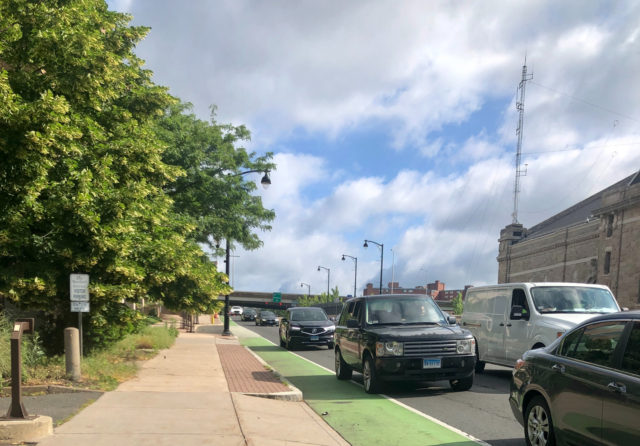
When you see this kind of behavior, you know how little protection paint offers you against someone raging behind the wheel, who is unlikely to think of anyone besides herself, at least not in this moment.
We don’t have to live this way, racing around from one light to the next, pretending to be NASCAR drivers or on important missions. We could see each other as people, who have equal value whether we are inside or outside of a car, regardless of where we are going. We could behave as if waiting an extra five seconds for someone to be safe is more important than getting to the parking lot five seconds sooner.
I catch my bus without incident. I get dropped off by Elizabeth Park, to enjoy the roses on a vacation day. I’m visiting with friends, here and there, trying to not do anything resembling work on my birthday, trying to not think about how the next day I’ll be on air, talking for a couple minutes about that letter I wrote. I visit with a friend who, despite being visible and in the part of the street where pedestrians would be expected, was hit by a driver last year. It still hurts for him to walk more than a mile, and he does not drive. The bus does not always run when he needs it, and Uber/Lyft gets expensive.
Walking around Elizabeth Park, the noise from parking lot construction punctuates the conversation. Why build out that gravel lot? Does the Elizabeth Park Conservancy want to showcase the gorgeous flowers, or the excessive number of parking opportunities in the park? What’s their goal? Conserving nature or parking? The irritation passes as I watch a large group of elderly folks walking on the road around the rose garden. Previously, they would not have been able to safely do this, as that space had also been taken up by vehicles. We can thank Hartford’s DPW for making parks safer and more accessible by removing cars from sections of them.
By the time I go on the radio on Tuesday, I’ve put together what I want to say. I time myself. I rehearse not saying “Where do engineers get off thinking what they’ve done deserves a pat on the back?” and I tell myself that as much as I dislike the prospect of live radio, it’s necessary that women speak about these issues. Transportation is a male-dominated field. I think about how I will have to establish my credibility to speak, because I am not someone who wears fancy titles, though I have certainly done the work. I’m not some random concerned citizen. I know that of which I speak. I’ve done the paid and the unpaid work.
When another pedestrian or cyclist is killed in Connecticut, I add the crash site to a map. I want there to be transparency about how frequently people die on our state’s roads.
One that shows all serious injuries would give a more accurate picture, but the news does not report every time a driver causes serious injuries to a pedestrian or cyclist.
I’ve been going through West Hartford’s crash data, and it basically breaks down to one pedestrian or cyclist getting injured (anything from minor to fatal) every week and a half. And since we know not all crashes get reported, it’s probably more like one a week. You are not hearing about every crash. Not even close.
I look through the pics on my phone to see what jars my memory. How was this week different from the last? How is it more than a string of upsetting pedestrian fatalities?
There are the uninviting beg buttons that if you don’t press, you never get a walk signal.
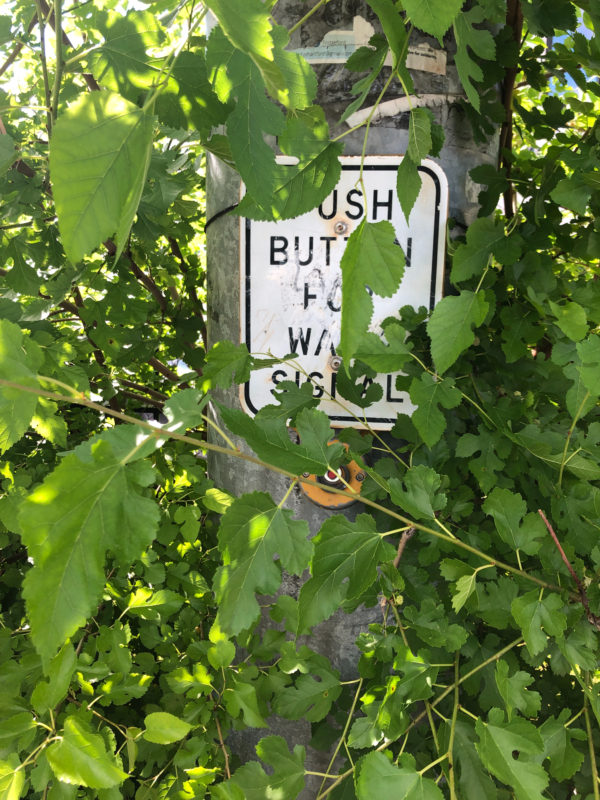
This is on Sisson Avenue in Hartord. I was on my way to Bartholomew Avenue, where pedestrians are inconvenienced and put in harm’s way. On Park Street, a scissor lift blocks the sidewalk on the south side of the road, but that’s what you would use to easily access Bartholomew. So, I cross the street, knowing I need to cross back over in a block. I do that. There’s new sidewalk that looks blocked off on one side of Bartholomew.
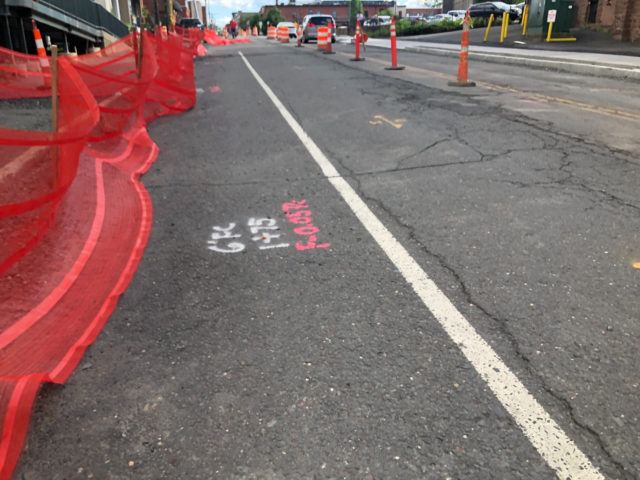
The other side has no pedestrian access preserved. So, I do the thing I hate to do, that I avoid: I walked in the travel lane of Bartholomew Avenue. I was lucky with my timing and only needed to dodge one car. There’s no back entrance to the building, not for the public anyway, and even if there were, Pope Park Highway #4 almost entirely lacks sidewalks.
There are reasons to keep pedestrians and cyclists in separate spaces from vehicles.
And yet. . .
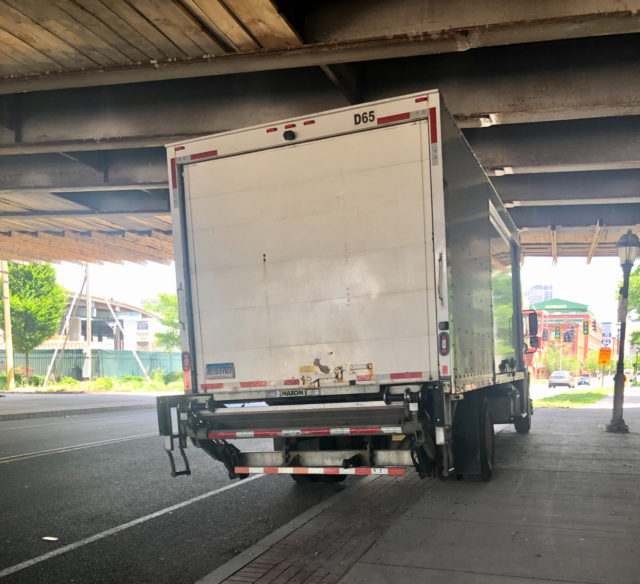
This is a truck that someone has beached in the bike lane and across part of the sidewalk on Capitol Avenue. While there’s space to pass on the sidewalk, it’s unnerving. Is there a driver inside? Is he paying attention? Will he start truck up while I’m right next to it and roll into me? I’m relieved to make it by unscathed, and then when I reach my destination, I report this to Hartford 311 and Bike Lane Uprising.
Which is also what I do the next day when I see a truck parked in the Farmington Avenue bike lane right at the intersection with Woodland Street. Is there a secret competition among drivers to see who can do the most dangerous parking job?
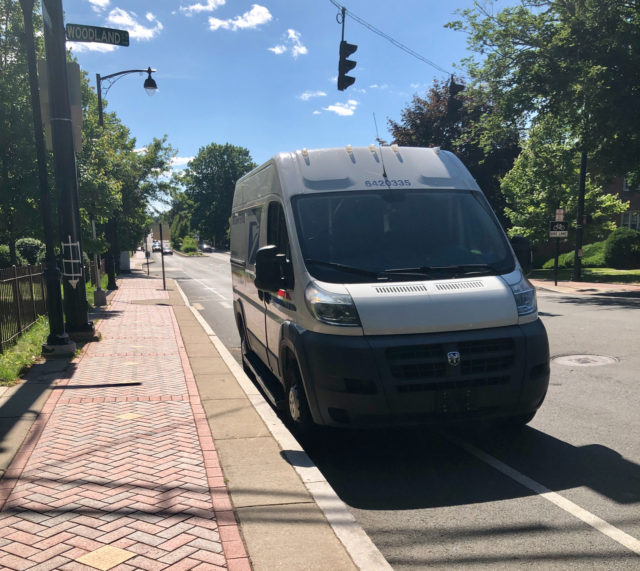
People seem to think “it’s just for a second” and it’ll be okay, but these actions have consequences. About twenty minutes after I saw the Farmington Ave bike lane blocked, I was on Capitol Avenue and watching this scene during rush hour: a driver who missed her turn onto Park Terrace erratically pulls into the Capitol Avenue bike lane and stops. The cyclist, riding correctly in the bike lane, has to swerve to avoid colliding with her vehicle. The person driving behind the cyclist lays on the horn. The cyclist was wearing hi-vis and the honking driver should have anticipated this maneuver. The automobilist who blocked the bike lane. . . well, her window was down and I let her know what I thought of her thoughtless maneuver. The cyclist was luckily fast and quick, and he didn’t hit the car that blocked his lane, nor did he get hit by a driver.
Not everything is terrible. Some things I encounter are just weird. Not far from the discarded fake nails and braids, I notice a bike rack randomly installed in a glorified traffic island on Washington Street. I wonder why this wasn’t installed outside of the nearby Bushnell, where people repeatedly request bike parking.
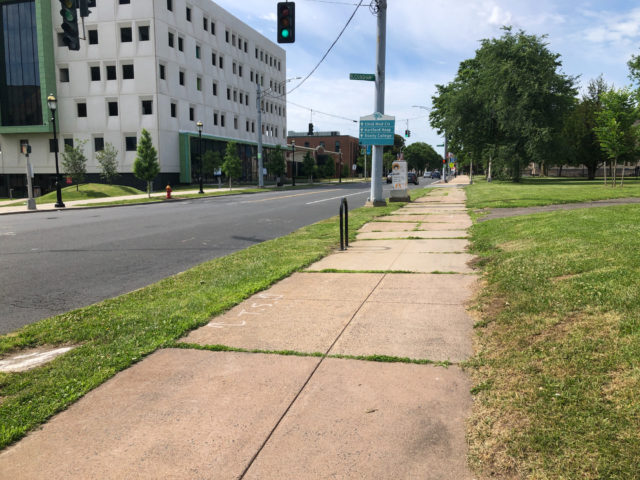
Another day, I’m walking along, thinking about how so much of the nonsense I experience (and write about here) would be avoided if moving around outside of cars were normalized.
This is not a lifestyle experiment or some weird anomaly in certain neighborhoods, but those neighborhoods have not had much political power. There’s a bike lane, but it’s not barrier-protected and is poorly maintained. There’s a roundabout, but lane-width in it and leading to it do not discourage speeding. Flex posts were installed, but the stop lines were not repainted. The most effective traffic calming — whole barriers — were implemented on streets where most people were already traveling at lower speeds. Broad and Capitol, Park and Park Terrace, and Farmington and Sigourney — just to name a few spots — have received no traffic calming. Nothing noteworthy, anyway.
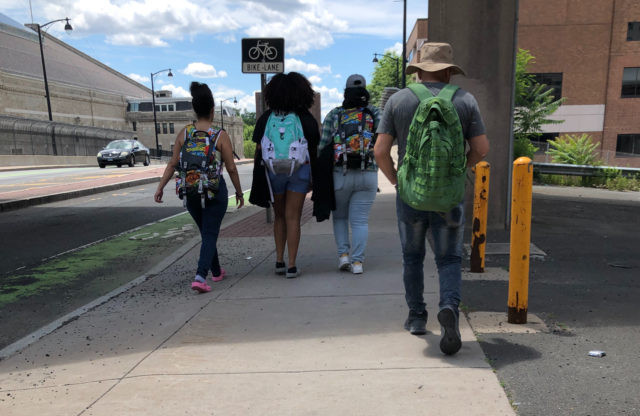
Without these distractions, I could more easily talk about living free of car ownership.
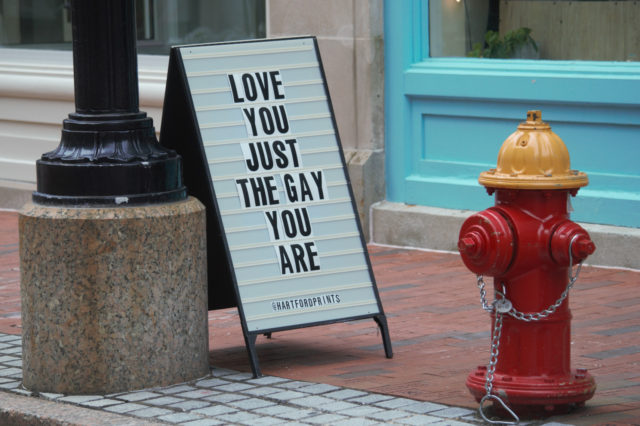
How the previous weekend, I walked myself and a picnic to Bushnell Park and listened to the Hartford Symphony Orchestra give a free performance outdoors. I watched as some concertgoers did that silly thing where they rush to their cars before the show is over, so they can avoid traffic. Without a car, I did not need to think about this either way. There would be no shoulder-to-shoulder people jam leaving Bushnell Park for Frog Hollow.
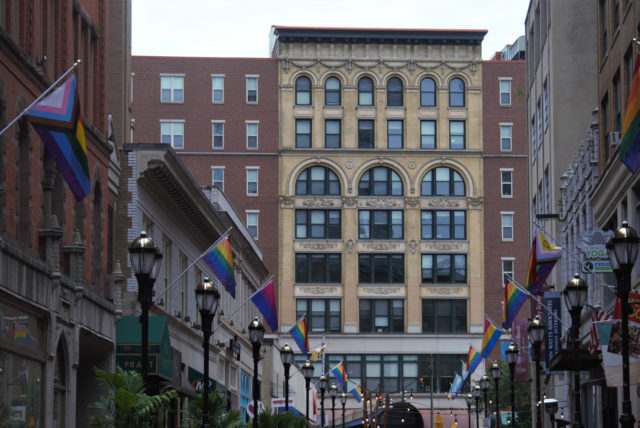
Without all the nonsense, I could focus on how on the most recent weekend, I walked through several parks and community gardens, breezing through the Taste of Hartford redux on Constitution Plaza. I can do these things without fretting over parking. I could talk about how I carried leftover birthday cake across town, and it arrived messy but still good.
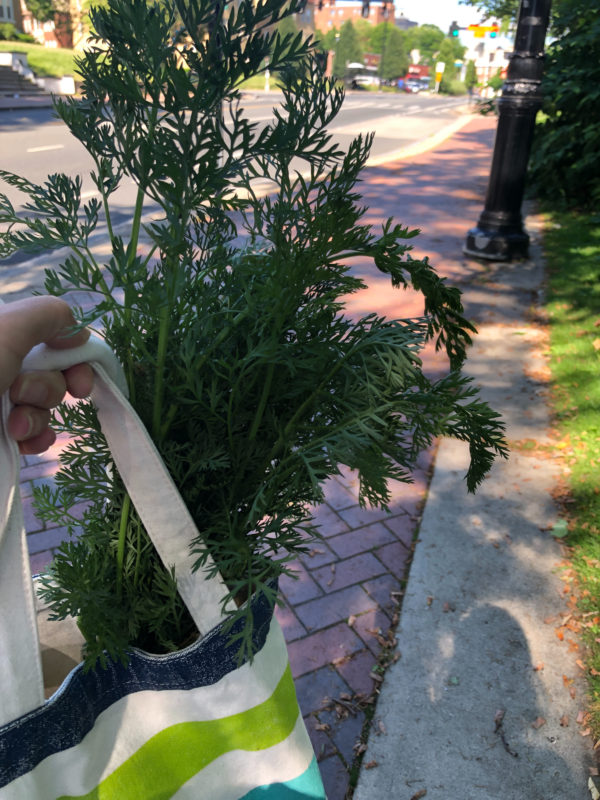
How I snagged fresh, local strawberries from the farmers’ market. . . never needing to get in a car or even on a bus to fetch them.
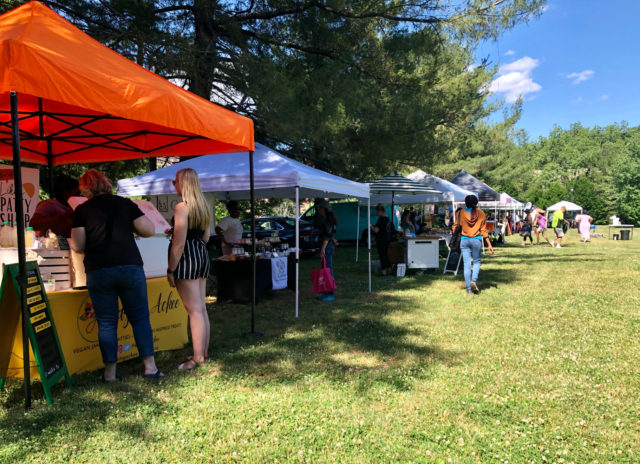
THE TWEETS THAT GIVE ME LIFE
As you watch this video and explore the Bike Lane Uprising thread, keep in mind that none of us starts off sitting on asphalt in front of delivery vehicles. We generally begin going through all the proper channels. We behave with civility. We join committees. We get nowhere. We create apps and networks. We see law enforcement selectively enforce the law. We see cities fail to design well. We don’t come out screaming, but at some point, after getting nowhere, direct action becomes another tool.
Ladies and gentlemen we have ourselves another standoff @ClintonBikeLn I’m not moving @USPS y’all need to back up and vacate the bidirectional bike lane. @AldReilly pic.twitter.com/uSj6nwvppo
— Bike Lane Uprising® (@bikelaneuprise) June 11, 2022
WHAT NEXT
- Listen to that Where We Live episode
- Sign up for the data training, so that you can confidently talk about the causes of crashes and where the most severe ones happen
- Report blocked bike lanes using the Bike Lane Uprising app or website.
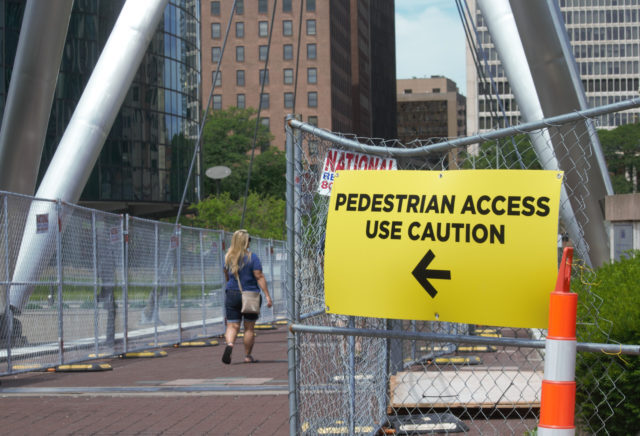
Tom
Check out the closed bike path under RT 2 in East Hartford. They’re replacing the overpass but forcing path users to go up by goodwin college to get thru.
While they were setting up the footings for the temporary bridge it was almost comical on how much the path shrunk.